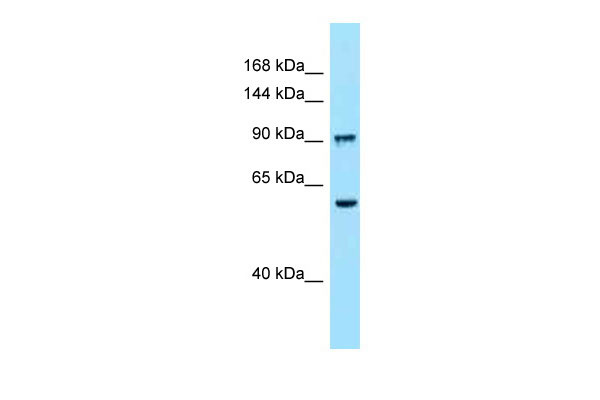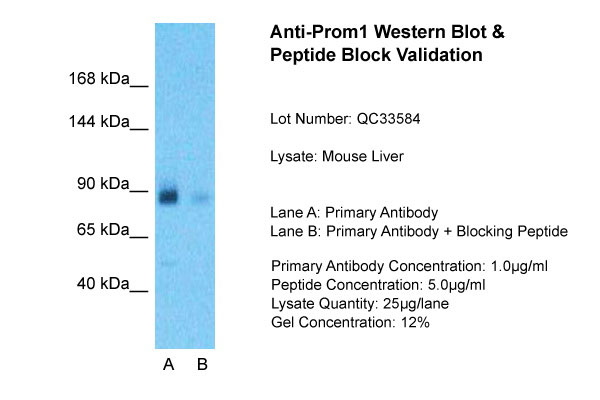Prom1 antibody - N-terminal region
Rabbit Polyclonal Antibody
- 产品详情
- 实验流程
Application
| WB |
|---|---|
| Primary Accession | O54990 |
| Other Accession | NM_001163577, NP_001157049 |
| Reactivity | Human, Mouse, Rat, Zebrafish, Dog, Guinea Pig, Horse, Bovine |
| Predicted | Human, Mouse, Rat, Zebrafish, Pig, Chicken, Dog, Guinea Pig, Horse, Bovine |
| Host | Rabbit |
| Clonality | Polyclonal |
| Calculated MW | 97113 Da |
| Gene ID | 19126 |
|---|---|
| Alias Symbol | 4932416E19Rik, AC133, CD133, Prom, Prom-1, Proml1 |
| Other Names | Prominin-1, Antigen AC133 homolog, Prominin-like protein 1, CD133, Prom1, Prom, Proml1 |
| Format | Liquid. Purified antibody supplied in 1x PBS buffer with 0.09% (w/v) sodium azide and 2% sucrose. |
| Reconstitution & Storage | Add 50 ul of distilled water. Final anti-Prom1 antibody concentration is 1 mg/ml in PBS buffer with 2% sucrose. For longer periods of storage, store at 20°C. Avoid repeat freeze-thaw cycles. |
| Precautions | Prom1 antibody - N-terminal region is for research use only and not for use in diagnostic or therapeutic procedures. |
| Name | Prom1 |
|---|---|
| Synonyms | Prom, Proml1 |
| Function | May play a role in cell differentiation, proliferation and apoptosis. Binds cholesterol in cholesterol-containing plasma membrane microdomains and may play a role in the organization of the apical plasma membrane in epithelial cells. During early retinal development acts as a key regulator of disk morphogenesis (PubMed:19228982). Involved in regulation of MAPK and Akt signaling pathways. In neuroblastoma cells suppresses cell differentiation such as neurite outgrowth in a RET-dependent manner. |
| Cellular Location | Apical cell membrane; Multi-pass membrane protein. Cell projection, microvillus membrane; Multi-pass membrane protein. Cell projection, cilium, photoreceptor outer segment Endoplasmic reticulum. Endoplasmic reticulum-Golgi intermediate compartment. Note=Found in extracellular membrane particles in various body fluids such as ventricular fluid of the developing brain and urine |
| Tissue Location | In the submandibular gland, expressed on the apical side of epithelial cells. In the parotid gland, expressed in the intercalated ducts. In the sublingual gland, expressed in intercalated ducts. In the extraorbital lacrimal gland, expressed in the intercalated tubules and larger intralobular ducts. Expressed in the retina. Present in urine within small membrane particles (at protein level). In the embryo, expressed on the apical side of neuroepithelial cells and of other epithelia such as lung buds, gut and ureter buds. In the adult, expressed at the apical side of the kidney tubules and of the ependymal layer of the brain. Not expressed in gut, liver, lung, pituitary, adrenal, heart or spleen. Localized to the nascent disk membranes at the base of the rod outer segment in the retina (at protein level). |
Research Areas
For Research Use Only. Not For Use In Diagnostic Procedures.
Application Protocols
Provided below are standard protocols that you may find useful for product applications.
REFERENCES
Miraglia S.,et al.Blood 90:5013-5021(1997).
Weigmann A.,et al.Proc. Natl. Acad. Sci. U.S.A. 94:12425-12430(1997).
Fargeas C.A.,et al.J. Cell Sci. 117:4301-4311(2004).
Carninci P.,et al.Science 309:1559-1563(2005).
Roeper K.,et al.Nat. Cell Biol. 2:582-592(2000).
终于等到您。ABCEPTA(百远生物)抗体产品。
点击下方“我要评价 ”按钮提交您的反馈信息,您的反馈和评价是我们最宝贵的财富之一,
我们将在1-3个工作日内处理您的反馈信息。
如有疑问,联系:0512-88856768 tech-china@abcepta.com.























 癌症的基本特征包括细胞增殖、血管生成、迁移、凋亡逃避机制和细胞永生等。找到癌症发生过程中这些通路的关键标记物和对应的抗体用于检测至关重要。
癌症的基本特征包括细胞增殖、血管生成、迁移、凋亡逃避机制和细胞永生等。找到癌症发生过程中这些通路的关键标记物和对应的抗体用于检测至关重要。 为您推荐一个泛素化位点预测神器——泛素化分析工具,可以为您的蛋白的泛素化位点作出预测和评分。
为您推荐一个泛素化位点预测神器——泛素化分析工具,可以为您的蛋白的泛素化位点作出预测和评分。 细胞自噬受体图形绘图工具为你的蛋白的细胞受体结合位点作出预测和评分,识别结合到自噬通路中的蛋白是非常重要的,便于让我们理解自噬在正常生理、病理过程中的作用,如发育、细胞分化、神经退化性疾病、压力条件下、感染和癌症。
细胞自噬受体图形绘图工具为你的蛋白的细胞受体结合位点作出预测和评分,识别结合到自噬通路中的蛋白是非常重要的,便于让我们理解自噬在正常生理、病理过程中的作用,如发育、细胞分化、神经退化性疾病、压力条件下、感染和癌症。







